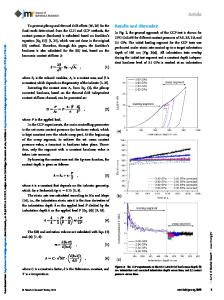Elevated-temperature creep of high-entropy alloys via nanoindentation
- PDF / 3,672,417 Bytes
- 7 Pages / 585 x 783 pts Page_size
- 12 Downloads / 395 Views
Introduction High-entropy alloys (HEAs), composed of multiple principal elements, tend to form a single-phase solid solution because of their high configurational entropy.1,2 This new class of materials shows interesting properties, such as promising strength and ductility,3–5 and good corrosion,6,7 irradiation,8 and wear resistance.9 In particular, hightemperature properties of HEAs, such as high-temperature strength10,11 and good thermal and microstructure stability,12,13 are important and necessary for elevated-temperature engineering applications,14 such as in gas turbines in the aerospace industry.10,14,15 Nanoscale time-dependent mechanical testing of alloy materials is usually conducted via microelectromechanical systems (MEMS)16 or nanoindentation systems.17 For the latter, with the high accuracy of depth-sensing technology and stable temperature-controlling stages in current instruments, the timedependent mechanical behavior of HEAs can be conducted on localized regions, ignoring the limit of standard-sized specimens, especially in traditional creep testing. Several studies have reported the time-dependent mechanical properties of HEAs via nanoindentation, including the elevated-temperature
creep of FeCoNiCrMn and FeCoNiCrMn-Al HEAs at 300– 600°C,18 room-temperature creep of as-deposited and annealed CoCrFeCuNi HEA thin films,19 room-temperature creep of as-cast and severelyplastic-deformed CoCrFeMnNi,20 initial creep behavior of CoCrNi HEA,21 characteristics of plastic deformation in CoCrFeMnNi HEA from room temperature to 300°C,22 strain rate sensitivity of AlCoCrFeNi HEA at room temperature,23 room-temperature creep in CoCrFeNiCu HEA with a face-centered-cubic (fcc) structure,24 and room-temperature creep in CoCrFeNiCuAl2.5 HEA with a body-centered-cubic (bcc) structure.24 In this article, we focus on creep properties, explored using nanoindentation, on several well-known HEAs, such as FeCoNiCrMn (also known as the Cantor alloy) and extended alloy systems. Several important parameters that play an important role in creep behavior are discussed, such as minor solute addition effects in HEAs, structure effects, grain-size effects, and orientation effects. This article summarizes the current findings in HEAs based on nanoindentation creep. It is hoped that more exploration using this new method of nanoindentation can provide new scientific findings on the high-temperature properties of HEAs.
P.H. Lin, Department of Materials and Optoelectronic Science, National Sun Yat-sen University, Taiwan; [email protected] H.S. Chou, National Sun Yat-sen University, Taiwan; [email protected] J.C. Huang, National Sun Yat-sen University, Taiwan; and City University of Hong Kong, Hong Kong; [email protected] W.S. Chuang, National Sun Yat-sen University, Taiwan; [email protected] J.S.C. Jang, Institute of Materials Science and Engineering, National Central University, Taiwan; [email protected] T.G. Nieh, The University of Tennessee, USA; and City University of Hong Kong, Hong Kong; [email protected] d
Data Loading...










